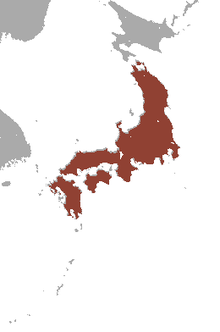Japanese badger
| Japanese badger | |
|---|---|

| |
| At Inokashira Park Zoo, Tokyo | |
| Scientific classification | |
| Domain: | Eukaryota |
| Kingdom: | Animalia |
| Phylum: | Chordata |
| Class: | Mammalia |
| Order: | Carnivora |
| Family: | Mustelidae |
| Genus: | Meles |
| Species: | M. anakuma
|
| Binomial name | |
| Meles anakuma Temminck, 1844
| |

| |
| Japanese badger range | |
The Japanese badger (Meles anakuma) is a species of
Description

Japanese badgers are generally smaller (average length 79 cm (31 in) in males, 72 cm (28 in) in females) and less sexually dimorphic (except in the size of the canine teeth) than their European counterparts.[1][3] Tail length is between 14 and 20 cm (5.5 and 7.9 in). This species is similar or mildly larger than the Asian badger. Adults usually weigh from 3.8 to 11 kg (8.4 to 24.3 lb).[4][5] The average weight of female Japanese badgers in one study from the Tokyo area was found to be 6.6 kg (15 lb) while that of males was 7.76 kg (17.1 lb).[6] In the Yamaguchi Prefecture, the average spring weight of female and male Japanese badgers was 4.4 kg (9.7 lb) and 5.7 kg (13 lb).[7] The torso is blunt and limbs are short. The front feet are equipped with powerful digging claws. The claws on hind feet are smaller. The upper coat has long gray-brown hair. Ventral hair is short and black. The face has characteristic black-white stripes that are not as distinct as in the European badger. The dark color is concentrated around the eyes. The skull is smaller than in the European badger.[1]
Origin
The absence of badgers from
Habits
Like other members of Meles, Japanese badgers are
Habitats
These badgers are found in a variety of woodland and forest habitats.[1]
Folklore
In Japanese mythology, badgers are shapeshifters known as mujina. In the Nihon Shoki, mujina were known to sing and shapeshift into other humans.
Diet
Similar to other
Threats
Although it remains common, the range of M. anakuma has shrunk recently.[1] Covering an estimated 29 per cent of the country in 2003, the area had decreased 7 per cent over the previous 25 years.[1] Increased land development and agriculture, as well as competition from introduced raccoons are threats. Hunting is legal but has declined sharply since the 1970s.[1]
In 2017, concern was raised by an upsurge in badger culling in Kyushu. Apparently encouraged by local government bounties and increased popularity of badger meat in Japanese restaurants, it is feared the culling may have reached an unsustainable level.[9][10]
See also
- Mujina, a badger creature from Japanese folklore
- Blakiston's Line, the faunal boundary line drawn between Hokkaidō in the north and Honshū, south of it, while certain animal species can only be found north of the line, certain other species can only be found south of it.
References
- ^ . Retrieved 19 November 2021.
- OCLC 62265494.
- ^ Kaneko, Y., Maruyama, N. and Kanzaki, N. 1996. Growth and seasonal changes in body weight and size of Japanese badger in Hinodecho, suburb of Tokyo. Journal of Wildlife Research 1: 42-46.
- ^ Tanaka, H. (2006). Winter hibernation and body temperature fluctuation in the Japanese badger, Meles meles anakuma. Zoological science, 23(11), 991-997.
- ^ Yoshimura, K., Shindo, J., & Kageyama, I. (2009). Light and scanning electron microscopic study on the tongue and lingual papillae of the Japanese badgers, Meles meles anakuma. Okajimas folia anatomica Japonica, 85(4), 119-127.
- ^ Kaneko, Y., & Maruyama, N. (2005). Changes in Japanese badger (Meles meles anakuma) body weight and condition caused by the provision of food by local people in a Tokyo suburb. Mammalian Sci, 45, 157-164.
- ^ Tanaka, H. 2002. Ecology and Social System of the Japanese badger, Meles meles anakuma (Carnivora; Mustelidae) in Yamaguchi, Japan. Ph.D Thesis, Yamaguchi University.
- ISSN 0952-8369.
- .
- PMID 28406210.

